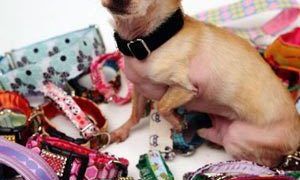“This post contains affiliate links, and I will be compensated if you make a purchase after clicking on my links.”
Do you know how to choose the right dog collar to train or control your pet? There are several different types available, and should be chosen according to the needs of your dog.
Successfully training your dog, as many experts say, depends on the equipment you use, and dog collars are included in the list. Dog trainers and owners sometimes have no idea of which equipment best suits their dog, because nowadays, there are hundreds if not thousands of them to choose from – different brands and types of collars, muzzles, and leashes. And for those who want to have a good idea on what type of collar they should buy for their dog, here is a guide to different collars and what kind of dog behavior best suits it.
How to Choose the Right Dog Collar
- Flat or Buckle Collar – this is the most common collar available in the market, and is more than sufficient for the vast majority of dogs. These are available in cloth, leather or nylon material. It fits around your dog’s neck, and is recommended for dogs that love to walk and take it easy. But this is not recommended for dogs that love to pull against the leash because they might choke and damage their trachea.
- Head Collar or Halter – this one looks like the halter used on a horse to pull his head and follow a specific direction. It is a neck and muzzle collar for your dog, and just like a horse’s halter, it allows you to control the direction your dog should go. Its good design is also safe for dogs and you don’t need to worry about any painful effects, unlike the buckle collar. However, some dogs have issues with this type of collar, as they tend to get uncomfortable while wearing it, and sometimes may even attempt to remove their collar or refuse to move or walk.
- Slip collar – slip collars are a bit similar to normal collars, but have a safer feature – they only tighten on a restricted point, so your dog is safe from choking and suffocation. Even with that, it still gives you control over your dog. It is easy to put on your dog, as it only goes over your dog’s head and snaps around his neck. But if your dog is a consistent puller, then this collar might not work as you planned.
- Choke collar – this type of collar should be used with great care, as it is only used for aggression cases, in which you cannot control the dog anymore and it is causing damage to people and pets. It is also used for aggression training. When you jerk or pull it up, it tightens, but releases when you let go of it. Remember to play safe when using this collar as it can put your dog’s life in danger and may even cause trauma. The “prong’ collar mentioned below is usually a better choice.
- Harnesses – these are placed around your dog’s chest, back and shoulders, and are soft and safe for your dog. Compared to a leash, it distributes the pulling force throughout the dog’s body. However, its disadvantages appear when a dog tends to pull harder.
- Prong collar – these are made for pulling dogs, because they are safe despite their appearance being similar to that of a choke collar. It has spaced prongs, creating an equally distributed force around the neck, but without direct pressure on the trachea compared to a choke collar.
One other thing to consider is the proper fit. A good way to get it right is to follow these instructions from an article on Drs. Foster and Smith’s website:
Dog Collars should be snug with enough room to fit two fingers between your dog’s neck and his collar. For your dog’s safety, the collar should not be loose enough to slip over the pet’s head. Collars should also not be so tight as to restrict breathing or cause coughing. Check collar size frequently on growing puppies. Use a tape measure to measure your pet’s neck, then add on two to three inches.
Keep the above in mind when you need to know how to choose the right dog collar. Please Share this article with others below.



















